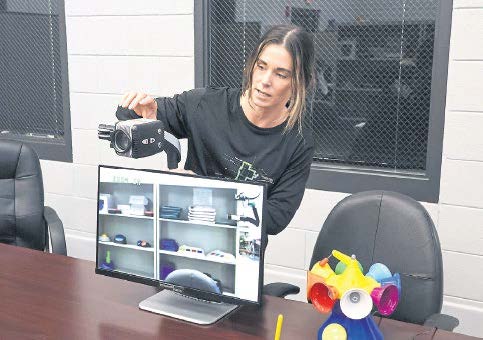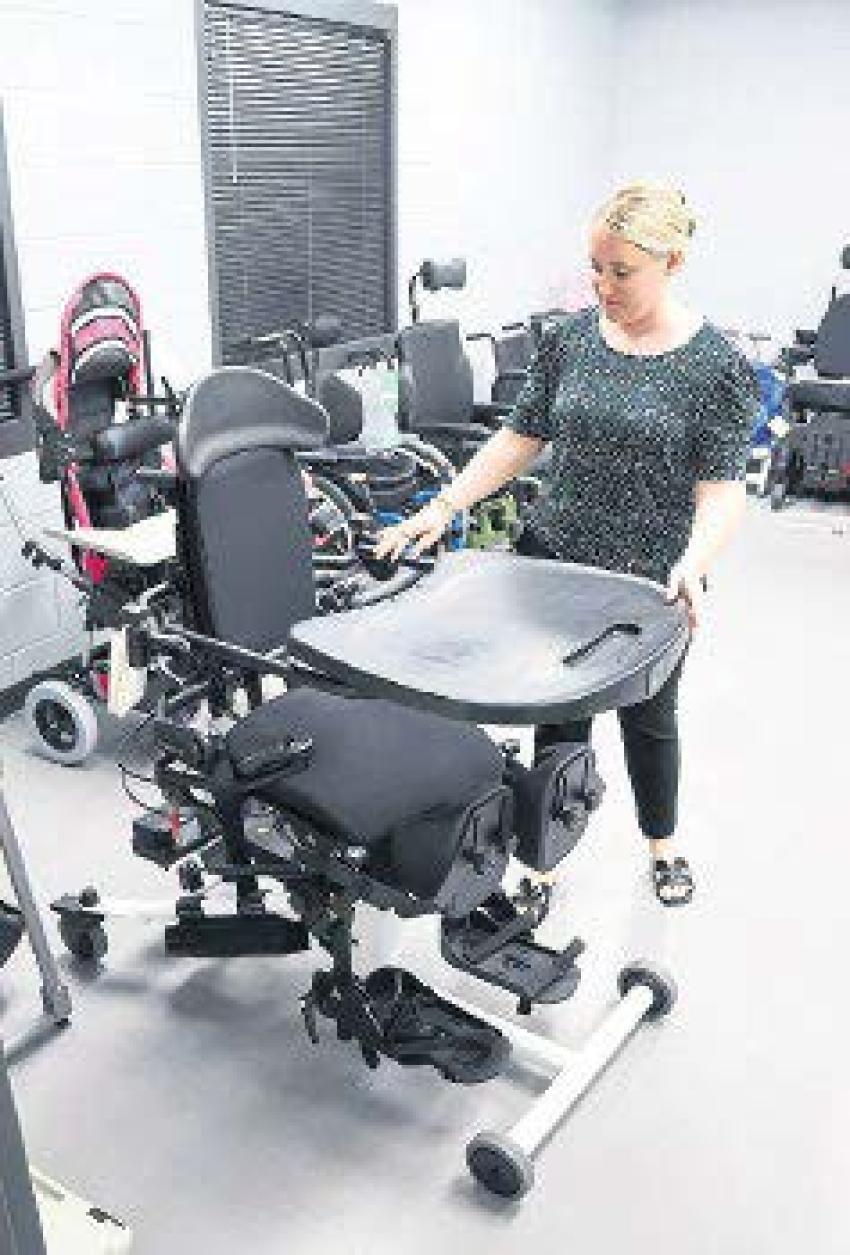Establishing Independence
Wendell Foster provides assistive technology for community, state
By Freddie Bourne
Messenger-Inquirer

Photo by Alan Warren, Messenger-Inquirer | awarren@messenger-inquirer.com
Kassandra Hester, assistive technology assistant, demonstrates how an Enhanced Vision device operates for someone who has low vision on May 12 at Wendell Foster’s Assistive Technology and Resource Center.
Last month, National Assistive Technology Awareness Day was celebrated on April 30 — recognizing the important role the technology plays for people with disabilities.
But for Wendell Foster, it is celebrated and utilized all year round as the local nonprofit organization has its own Assistive Technology (AT) and Resource Center on its Triplett Street campus. According to a Wendell Foster press release, the center — one of the five AT centers in Kentucky through the Kentucky Assistive Technology Services (KATS) Network — provides assistive technology services through a variety of programs for the community at large.
“(People) can come in here and try things … or demo something to make sure it’s going to be a good fit for them,” said Cindy Huston, the center’s director. “... Teachers, family members, employment counselors — really, we serve all ages and all abilities; not just people here that (receive services) or live at Wendell Foster.”
AT, as defined by the Illinois-based not-for-profit Assistive Technology Industry Association (ATIA), includes equipment, products and systems that “enhance learning, working and daily living for people with disabilities” to help “increase, maintain, or improve the functional capabilities.”
“It’s basically anything that’s going to help a person to be more independent,” Huston said.
Huston said the technology available in the center would be classified as “low-to-mid tech,” with purposes ranging from assisting with communication, hearing, vision, computer accessibility, mobility, adaptive seating, leisure and recreation and more.

Photo by Alan Warren, Messenger-Inquirer | awarren@messenger-inquirer.com
Kara Howard, vice president of development and community engagement, looks over an EasyStand standing frame on May 12 that is kept inside Wendell Foster’s Assistive Technology and Resource Center.
One common example includes adaptive switches, which Huston said “is sort of a cornerstone of a lot of technology.”
“Just like a light switch activates the light, there are different types of switches that activate different things,” Huston said, who mentioned the switches “come in all shapes and sizes.”
One example of how switches can be used is with toys such as the standard Nerf blaster, which Huston said has some prior history.
“A parent came in whose child was in a wheelchair, not able to access Nerf guns in a typical way. When (their) grandpa comes over at Christmas, they always have a big Nerf gun fight,” she said. “So now (the child) was actually able to participate with his siblings.
“Switches and adaptive toys … give them that opportunity to learn just like a typical child would,” Huston said. “... It’s about engaging with their family, their environment, with their peers — just a way to be included.”
The center, which Huston estimates has been in existence for about 17 years, has continued to see an influx of new and updated technologies coming in, though earlier models of equipment on-hand are still effective.
“It’s definitely a learning curve …,” she said, “but I think also from that perspective, not everybody’s comfortable with technologies — smartphones, iPads, that sort of thing — so it’s good to have options for different categories.
“There’s a lot of low vision things on your smartphones now, but not everybody’s comfortable using smartphones,” Huston said. “So it’s good to have just some old-fashioned desktop magnifiers, portable magnifiers, things like that.”
When it comes to funding the technology, Doug Hoyt, Wendell Foster’s chief executive officer, said it’s “through all possible sources.”
“The AT center is largely funded through some grants, but our community engagement team (is) actively and always looking for grant opportunities from individuals, and foundations and other ways of support,” he said.
Technologies such as tablets and specialized wheelchairs tend to be more costly, which in turn may lead the organization to building the funds into the overall budget, Hoyt said, “and then fundraise for it along the way.”
“It’s not inexpensive,” Hoyt said, who highlighted other equipment in stock such as gait trainers and ramps to assist with mobility.
According to Wendell Foster’s website, the center also includes a lending library — allowing people to loan items on a trial basis to assist in decision making, to serve as a loaner while a device is being replaced or to provide a short-term accommodation — and a reutilization program, which assists consumers in obtaining used equipment at no cost.
Though a lot of Wendell Foster clients utilize the AT services, Huston said the reach “goes beyond (the center’s) four walls.”
“We work with a lot of clinicians — speech therapists, occupational therapists, physical therapists — in the community; because a lot of times for people who have significant disabilities, they’re going to be working with one of those healthcare providers,” she said.
“Not everybody is familiar with it — the family member or the teacher — but they bring in that expert that is actually doing that hands-on work.”
Additionally, the center has been instrumental in fostering partnerships with students and teachers.
“We’ve worked with the low vision teacher at Daviess County Public Schools to allow them to borrow equipment … to make sure that it’s going to be a good fit before they ask the school system to fund it and to also provide a temporary accommodation,” Huston said. “(Recently), a student’s … desktop magnifier was sent off for repair, so they were able to borrow one from us to have that … to help with (the student’s) visual instruction.”
Huston said inventory continues to change on a constant basis and one should “check back frequently” if they are not able to find what they are looking for the first time around. “We’ll make a list (of requests), but then we’ll also contact the other centers from throughout the state,” she said. “We’ve had families drive from Fort Mitchell, Kentucky to Wendell Foster to get equipment ….”
Hoyt finds the need for AT “is certainly not declining” and finds the center itself to be a “hidden gem” for the entire commonwealth.
“We ship all across the state …. It’s not just right here in Owensboro,” he said, “... and everything done out of this part of our business is free.”
For Hoyt, providing a service like the center aligns with the organization’s overall goal of helping people be successful in their everyday lives.
“This is one area that helps in that regard,” he said, “but all areas of Wendell Foster do that same thing in their own way, in a different way.
“One of the things that we very frequently say is we’re not just helping that individual client; we’re helping a family,” Hoyt said.
For more information about Wendell Foster’s Assistive Technology and Resource Center, visit wendellfoster.org/technology-and-resource-center.